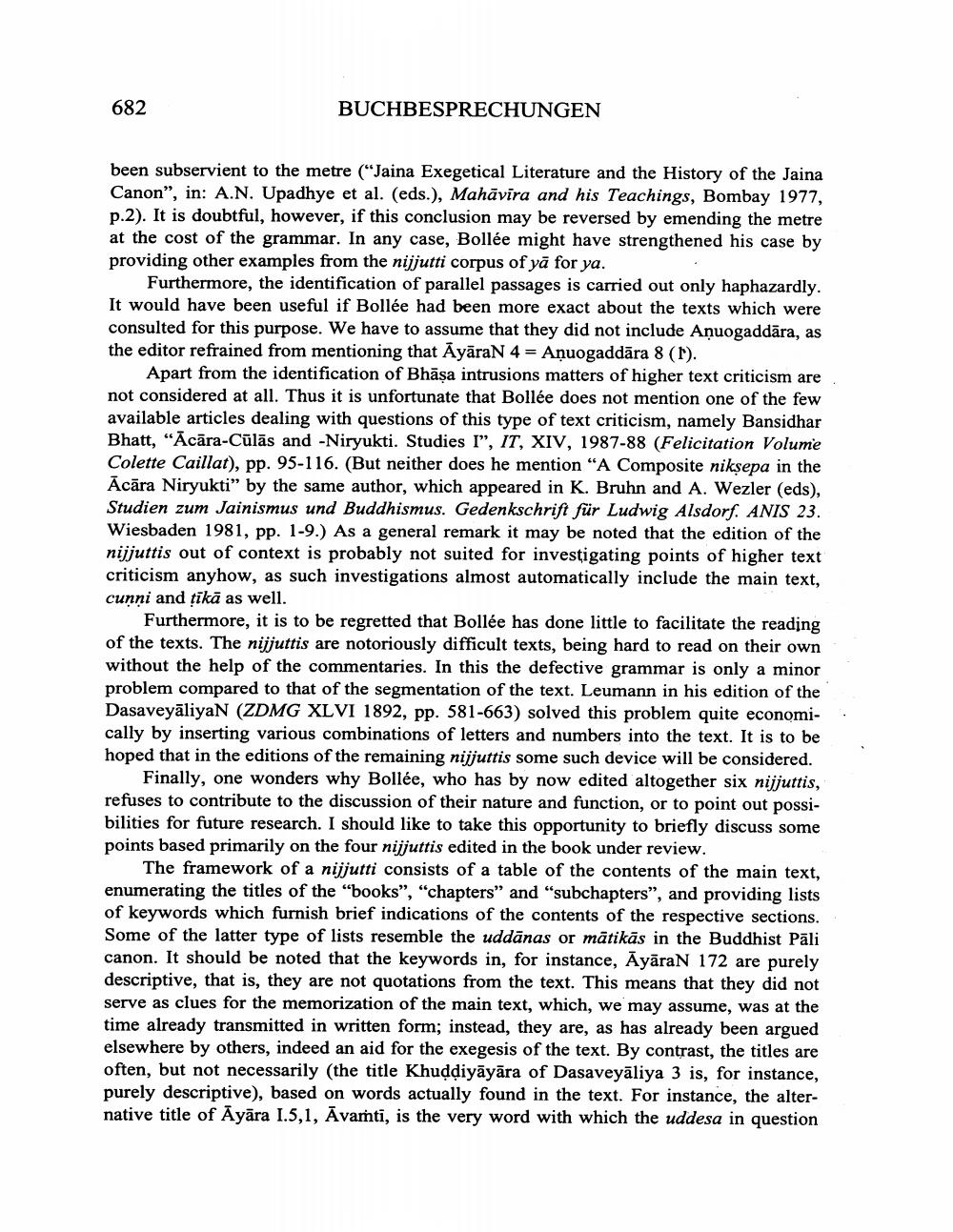Book Title: Buchbesprechungen Comptes Rendus Book Reviews Author(s): W B Bollee Publisher: W B Bollee View full book textPage 2
________________ 682 BUCHBESPRECHUNGEN been subservient to the metre ("Jaina Exegetical Literature and the History of the Jaina Canon”, in: A.N. Upadhye et al. (eds.), Mahāvīra and his Teachings, Bombay 1977, p.2). It is doubtful, however, if this conclusion may be reversed by emending the metre at the cost of the grammar. In any case, Bollée might have strengthened his case by providing other examples from the nijjutti corpus of yā for ya. Furthermore, the identification of parallel passages is carried out only haphazardly. It would have been useful if Bollée had been more exact about the texts which were consulted for this purpose. We have to assume that they did not include Aņuogaddāra, as the editor refrained from mentioning that ĀyāraN 4 = Aņuogaddāra 8 (1). Apart from the identification of Bhāsa intrusions matters of higher text criticism are not considered at all. Thus it is unfortunate that Bollée does not mention one of the few available articles dealing with questions of this type of text criticism, namely Bansidhar Bhatt, "Ācāra-Cūlās and -Niryukti. Studies I”, IT, XIV, 1987-88 (Felicitation Volume Colette Caillat), pp. 95-116. (But neither does he mention "A Composite niksepa in the Ācāra Niryukti" by the same author, which appeared in K. Bruhn and A. Wezler (eds), Studien zum Jainismus und Buddhismus. Gedenkschrift für Ludwig Alsdorf. ANIS 23. Wiesbaden 1981, pp. 1-9.) As a general remark it may be noted that the edition of the nijjuttis out of context is probably not suited for investigating points of higher text criticism anyhow, as such investigations almost automatically include the main text, cunni and ţikā as well. Furthermore, it is to be regretted that Bollée has done little to facilitate the reading of the texts. The nijjuttis are notoriously difficult texts, being hard to read on their own without the help of the commentaries. In this the defective grammar is only a minor problem compared to that of the segmentation of the text. Leumann in his edition of the DasaveyāliyaN (ZDMG XLVI 1892, pp. 581-663) solved this problem quite economi- : cally by inserting various combinations of letters and numbers into the text. It is to be hoped that in the editions of the remaining nijjuttis some such device will be considered. Finally, one wonders why Bollée, who has by now edited altogether six nijjuttis, refuses to contribute to the discussion of their nature and function, or to point out possibilities for future research. I should like to take this opportunity to briefly discuss some points based primarily on the four nijjuttis edited in the book under review. The framework of a nijjutti consists of a table of the contents of the main text, enumerating the titles of the "books", "chapters" and "subchapters”, and providing lists of keywords which furnish brief indications of the contents of the respective sections. Some of the latter type of lists resemble the uddānas or mātikās in the Buddhist Pāli canon. It should be noted that the keywords in, for instance, AyāraN 172 are purely descriptive, that is, they are not quotations from the text. This means that they did not serve as clues for the memorization of the main text, which, we may assume, was at the time already transmitted in written form; instead, they are, as has already been argued elsewhere by others, indeed an aid for the exegesis of the text. By contrast, the titles are often, but not necessarily (the title Khuddiyāyāra of Dasaveyāliya 3 is, for instance, purely descriptive), based on words actually found in the text. For instance, the alternative title of Āyāra 1.5,1, Āvamti, is the very word with which the uddesa in questionPage Navigation
1 2 3 4
